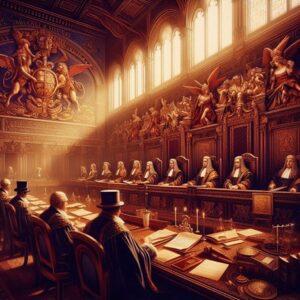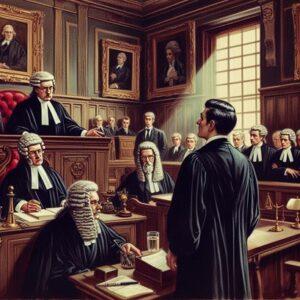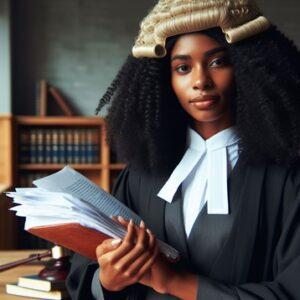Section 41 of the Criminal Justice Act 1925 (CJA 1925) makes it an offence to take any photograph, make or attempt to make any portrait or sketch of a justice or a witness in, or a party to, any proceedings before the court, either in the courtroom or its precincts. A court precinct are its buildings and land.
According to the CPS, the penalty on summary conviction is a fine not exceeding level 3 on the standard scale. A Level 3 fine is a maximum of £1,000 and is published on the Sentencing Council website. The CJA 1925, however only provides for a fine not exceeding £50.
(1) No person shall—
(a) take or attempt to take in any court any photograph, or with a view to publication make or attempt to make in any court any portrait or sketch, of any person, being a judge of the court or a juror or a witness in or a party to any proceedings before the court, whether civil or criminal; or
(b) publish any photograph, portrait or sketch taken or made in contravention of the foregoing provisions of this section or any reproduction thereof;
and if any person acts in contravention of this section he shall, on summary conviction, be liable in respect of each offence to a fine not exceeding fifty pounds.
Criminal Justice Act 1925 Section 41
The Criminal Justice Act 1925 comes into effect within the precinct of a Crown Court; whereas the Contempt of Court Act 1981 comes into effect on all other HMCTS sites.
The offence at s41 CJA 1925 can be charged as a criminal offence in accordance with the Director’s Guidance on Charging, or the underlying behaviour can be dealt with by the court as a contempt in accordance with the summary procedure at Rule 48.5 of the Criminal Procedure Rules – see R v D (Contempt of Court: Illegal Photography) [2004] EWCA Crim 1271, or on a later application to the High Court by the Attorney General.
If dealt with by summons or charge normal time limits apply. The decision whether to charge a criminal offence or to bring proceedings for contempt will depend on the facts of the case, including the gravity of the interference with the administration of justice.
In Solicitor General v Cox [2016] EWHC 1241 (QB) the Solicitor General brought proceedings for common law contempt in respect of photos and videos taken in court and posted online along with derogatory comments about the judge. The court found that both the taking and publication of the illegally taken images, accompanied by pejorative comments about a judge, amounted to contempt, in circumstances where the contemnor knew phones were banned and had acted in deliberate defiance of it. The court considered the gravity of the risks and of the interference with the due administration of justice in the case and held that proceedings for contempt, rather than prosecution of the criminal offence, were appropriate.
The case of Cox highlights the extent to which the use of social media can interfere with the administration of justice and the need to take appropriate action. Prosecutors should refer to the Criminal Practice Directions (CPD I General matters 6C. This clarifies the use which may be made of live text-based communications, such as mobile email, social media (including Twitter) and internet-enabled laptops in and from courts).
Where evidence exists of an offence contrary to s.41 CJA 1925 prosecutors should assist the court by reference to the above considerations. The court initially decides on whether action must be taken by application of the summary contempt procedure at Rule 48.5. In the magistrates’ court the summary contempt procedure must be completed that day – see Practice and Procedure below. If the court does not proceed in this manner a decision has to be made on whether to proceed by charge or to refer the matter to the Attorney General having regard to the gravity of the risks and interference with the due administration of justice in the case.
Two options
Photography in court – Crown Prosecution Service (CPS) Legal Guidance
- If the offender is apprehended on the day and the court is sitting advise court that it can deal with it as a contempt of court there and then, using the summary procedure at Rule 48.5 above, or have the police decide whether to charge an offence contrary to s.41 Criminal Justice Act 1925. If a magistrates’ court decides to deal with it there and then it may receive an apology but cannot impose a sanction – see Rule 48.5 procedure above.
- If the court does not deal with it there and then the normal police investigation and charge procedure applies. The offence is at s41 Criminal Justice Act 1925. Penalty is a level 3 fine. AG consent is not required so police can charge. Prosecutors note – there is no need to contact AGO when this scenario occurs unless the risks and interference with the due administration of justice was particularly grave. See Solicitor General v Cox where particularly serious issue.
Contempt of Court
Contempt of Court is conduct that denotes wilful defiance of, or disrespect towards the court, or that wilfully challenges or affronts the authority of the court or the supremacy of the law itself.
Photography Ban and the Crimes and Courts Act 2013
According to The Law Society Gazette article Court photography ban under review in transparency drive written by Monidipa Fouzder and published on the 11th May 2023 :-
A ban imposed nearly 100 years ago on photography in courts could be lifted under ideas being floated by the government to make the justice system more transparent.
A call for evidence published by the Ministry of Justice today asks if the 1925 prohibition on photography and 1981 prohibition on sound recording remain fit for purpose.
The Crimes and Courts Act 2013 allows the ban to be disapplied in certain circumstances by secondary legislation. For instance, the Court of Appeal and Competition Appeal Tribunal can broadcast proceedings. The Crown court can broadcast sentencing remarks. The Supreme Court is excluded from the two bans because cases heard by the UK’s highest court, which was established in 2009, would have previously been heard in the House of Lords where broadcasting was allowed.
Court photography ban under review in transparency drive
Video of Crown Court and Court of Appeal Cases
The latest cases as captured by Sky News cameras in the Crown Court and Court of Appeal are published on the Sky News – Courts YouTube Channel.
Please be advised that the published videos may contain graphic descriptions of serious crimes, including murder and sexual offences.
Check out our articles on Can you Criticise a Judge ?, Litigants in Person, McKenzie Friends, Horsham County Court, HHJ Farquhar, HHJ Bedford, R v Sussex Justices and the highly dubious Sussex Family Justice Board.
We have a number of links to Free Legal Resources and Legal Organisations on our Free Legal Advice , Legal Aid and Pro Bono pages.
Read the reviews of Gavin Howe Barrister
“He is awful, underhanded and should not be practising law!”
Latest Articles
- What is a Paralegal ?A paralegal is a legal professional who performs tasks that require knowledge of legal concepts but does not hold the… Read more: What is a Paralegal ?
- What is a Judgment ?A judgment, also known as a judicial decision or court ruling, is the final decision made by a court of… Read more: What is a Judgment ?
- What is an Adverse Inference ?Adverse inference is a legal principle that plays a significant role in various areas of law, including criminal, civil, and family law. It arises… Read more: What is an Adverse Inference ?
- BarristersA barrister is anyone who has been Called to the Bar in England and Wales. For a barrister to offer… Read more: Barristers




